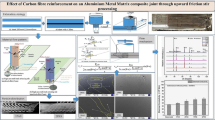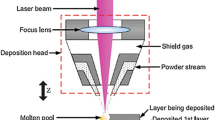Abstract
In this study, we prepared Cu–graphite composites with a bimodal structure by spark plasma sintering using CuO, nickel-plated graphite (Ni–Gra) and Y2O3 with different particle sizes. The presence of the bimodal structure was demonstrated by EBSD. The copper–graphite composites with bimodal structure effectively suppress strain localization of friction and wear, while graphite has a lubrication effect, which can greatly reduce the friction coefficient of the material. The microstructure of the material surface as well as the abrasion marks were analyzed by SEM and 3D profiling. The microstructure results show that the Cu2O generated during the sample preparation process can improve the bonding effect between Ni–Gra and Cu matrix. The frictional wear results show that the bimodal structure of the copper–graphite composite is excellent frictional wear performance, mainly due to which the ultrafine grains (UFGs) bear most of the load during the friction process, while the plastic deformation of the coarse grains (CGs) plays the role of supporting the UFGs.
Graphical abstract












Similar content being viewed by others
References
Zhao D, Zha S, and Liu D, J. Diamond Related Mater 115 (2021) 108.
Kovacik J, and Emmer S, J Int J Eng Sci 144 (2019) 103.
Moustafa S F, El-Badry S A, Sanad A M, and Kieback B, Wear 253 (2002) 699.
Xue C, Bai H, Tao P F, Wang J W, Jiang N, and Wang S L, Mater Des 15 (2016) 250.
Yuan Y, Gan X, Lai Y, Zhao Q, and Zhou K, Compos Interf 27 (2020) 449–463.
Peng Zhang, J Wear 202927 (2019) 432.
Zhang S, Kang H, and Wang Z, J J Alloys Compounds 860 (2020) 157888.
Kumar R A, Kumar K K, and Radhika N, J Silicon 11 (2019) 2613.
Ke Z, Zheng Y, Zhang G, Wu H, Xu X, Lu X, and Zhu X, J Ceram Int 46 (2020) 12767.
Zou C, Chen Z, and Guo E, J RSC Adv 8 (2018) 30777.
Ma E, J Scr Mater 49 (2003) 663.
Koch C C, Morris D G, Lu K, and Inoue A, MRS Bull 24 (2013) 54.
Mohammed S M A K, Chen D L, and Liu Z Y, J Mater Sci Eng A 817 (2021) 141370.
Moshkovich A, Perfilyev V, Lapsker I, and Rapoport L, J Wear 320 (2014) 34.
Singh M K, and Gautam R K, J Mater Today Proc 5 (2018) 5727.
Chen X, Ma Y, and Yang Y, J Scripta Mater 204 (2021) 114142.
Rigney D A, J Wear 245 (2000) 1.
Furlong O J, Miller B P, and Tysoe W T, J Tribol Lett 41 (2011) 257.
Chen X, Han Z, and Li X Y, J Scripta Mater 185 (2020) 82.
Haug C, Ruebeling F, and Kashiwar A, J Nat Commun 1 (2020) 11.
Li J, Chen T, Yun Z, and Xia X, J Int J Mech Sci 222 (2022) 107220.
Williamson G K, and Hall W H, J Acta Metallurgica 1 (1953) 22.
Zhang Q Y, The tribological properties research on ZrAlN coating by multi-arc ion plating, Jiangxi University of Science and Technology, Ganzhou (2018).
Acknowledgements
At present, this work was supported by the National Natural Science Foundation of China (No. 51761013) and the independent project of Jiangxi advanced Copper Industry Research Institute (ZL-202004).
Author information
Authors and Affiliations
Contributions
YS completed the laboratory, writing—original draft and revised the paper. ZS helped in conceptualization and methodology. DL worked in data curation and investigation. SL helped in conceptualization and writing—review and editing. JL worked in investigation and formal analysis. JZ and BY worked in supervision and writing—review and editing.
Corresponding author
Ethics declarations
Conflict of interest
There are no conflicts to declare.
Additional information
Publisher's Note
Springer Nature remains neutral with regard to jurisdictional claims in published maps and institutional affiliations.
Rights and permissions
Springer Nature or its licensor (e.g. a society or other partner) holds exclusive rights to this article under a publishing agreement with the author(s) or other rightsholder(s); author self-archiving of the accepted manuscript version of this article is solely governed by the terms of such publishing agreement and applicable law.
About this article
Cite this article
Zhang, J., Sun, Y., Sun, Z. et al. Effect of Bimodal Structure on the Frictional Properties of Copper–Graphite Composites. Trans Indian Inst Met 77, 637–647 (2024). https://doi.org/10.1007/s12666-023-03128-4
Received:
Accepted:
Published:
Issue Date:
DOI: https://doi.org/10.1007/s12666-023-03128-4




